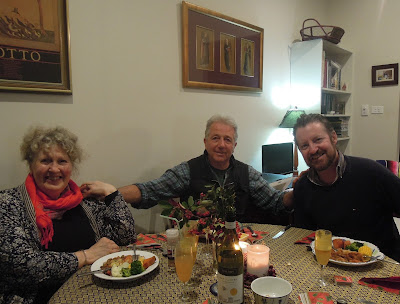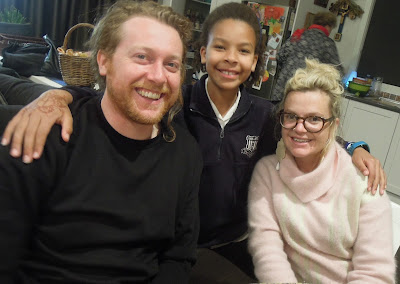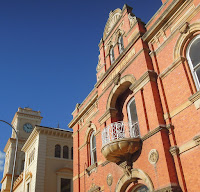Part 3: Goulburn and Canberra
This evening I share some more images and commentary on my recent visit to the Southern Highlands and Tablelands of New South Wales. This post focuses on time spent in Goulburn and Canberra. Part 1 in this series focused on Exeter and Mt. Alexandra, while Part 2 spotlighted Bundanoon and the Sunnataram Forest Monastery. My visit to this region of Australia is part of what I'm calling my "Australian Sojourn – Winter 2017" series. To start at the beginning of this broader series, click here.
Prior to my relocation to the U.S. in January 1994, I lived in Goulburn, Australia's "oldest inland city," for six years, teaching as a primary (or elementary) school teacher at Sts. Peter and Paul's Catholic School from 1988 to 1993. (For images from my teaching days in Goulburn, click here and here.)
Pictured above is the Goulburn Courthouse and the clock tower of the Goulburn Post Office. The Goulburn Courthouse opened in 1887. It is of Italianate style and was designed by the colonial architect James Barnet. Barnet also designed the Goulburn Post Office, built in 1880-1881.
Above: With my dear friends Cathy and Gerry Conroy – Wednesday, August 2, 2017. Gerry had been a teacher with me at Sts. Peter and Paul, and his wife Cathy and I had studied together part-time at the Australian Catholic University in nearby Canberra in 1991-1992.
Left: Cathy and Gerry's daughter Jacinta, her husband Antipas, and their children Sophie and Emmanuel. I was Jacinta's fourth grade teacher in 1989.
Above: Sophie (center) with Cathy and Gerry's youngest son Joe and Joe's girlfriend Charlotte.
Above: A lovely shot of Antipas and Emmanuel.
Above, right, and below: Some of the colonial era buildings of Goulburn.
Notes Wikipedia about the history of Goulburn and its surrounds:
Above: Perhaps Goulburn's most famous (and certainly most visible) landmark – the War Memorial atop Rocky Hill.
Built by public subscription in 1924 as a memorial to the men of Goulburn and district who served in the First World War, the stone tower that comprises the Goulburn War Memorial can be seen from miles around. At night, a powerful beacon of light from the top of the tower sweeps through the darkness.
Raising 20 metres from its position atop Rocky Hill, the lookout gallery at the top of the tower offers panoramic views of Goulburn and the surrounding area.
A nearby museum houses a collection of military artifacts and personal items used by soldiers in the two world wars, and documents Goulburn’s association with and contributions to these conflicts.
Above and below: My good friend Kerry (who lives in nearby Exeter) with a new Goulburn friend!
Above: Friends Michelle, Marion, Gerry, Joe, Cathy, and Jackie. When I taught at Sts. Peter and Paul's, Michelle, Marion, Gerry, and Jackie were colleagues of mine. It was great to catch up with them since last I visited, just over a year ago.
Above: With Kerry (center) and her sister Sandra. On the evening of Thursday, August 3, the three of us travelled to nearby Canberra for a very special event . . .
. . . the Canberra premiere of Bennelong, the latest performance piece of the Bangarra Dance Theatre, described as "one of Australia’s premier national Indigenous performing arts companies."
Left: Bennelong's choreographer and Bangarra's Artistic Director Stephen Page, who gave an informative talk before the performance.
Above and below: Two images by Daniel Boud from the Bangarra website, featuring Beau Dean Riley Smith (center in both images) as Woollarawarre Bennelong.
Writes Stephen Page in the Choreographer's Note in the Bennelong program booklet:
Continues Page:
I was quite moved by Bennelong – its story and message, and the way these were told and expressed through dance. Indeed, the two words that I would use to describe this latest work of the Bangarra Dance Theatre are beautiful and powerful.
Above and below: Two views of Civic, the name by which the central business district of Canberra is commonly known. It is also called Civic Centre, City Centre, Canberra City and Canberra.
Above: A view of Parliament House, Canberra – August 3, 2017.
Above: The last time I was in Canberra was with Kerry in 1998.
Following is how I describe our presence at Parliament House that day on my website Faces of Resistance: Images and Stories of Progressive Activism at the Turn of the Millennium (1997-2006)
Above: At Goulburn Railway Station with my good friends Cathy and Gerry, just before I boarded a northbound train to Sydney – Friday, August 4, 2017.
See also the previous Wild Reed posts:
• Journey to the Southern Highlands & Tablelands – Part 1: Exeter and Mt. Alexandra
• Journey to the Southern Highlands & Tablelands – Part 2: Bundanoon and the Sunnataram Forest Monastery
• Australian Sojourn – May 2016: Goulburn
• Australian Sojourn – March 2015: Goulburn
• The Southern Highlands (2007)
• Goulburn Revisited (2006)
• Goulburn Landmarks (2006)
• Goulburn Reunion (2006)
• The Australian Roots of My Progressive Catholicism
• Remnants of a Past Life (Part I)
• Remnants of a Past Life (Part II)
This evening I share some more images and commentary on my recent visit to the Southern Highlands and Tablelands of New South Wales. This post focuses on time spent in Goulburn and Canberra. Part 1 in this series focused on Exeter and Mt. Alexandra, while Part 2 spotlighted Bundanoon and the Sunnataram Forest Monastery. My visit to this region of Australia is part of what I'm calling my "Australian Sojourn – Winter 2017" series. To start at the beginning of this broader series, click here.
Prior to my relocation to the U.S. in January 1994, I lived in Goulburn, Australia's "oldest inland city," for six years, teaching as a primary (or elementary) school teacher at Sts. Peter and Paul's Catholic School from 1988 to 1993. (For images from my teaching days in Goulburn, click here and here.)
Pictured above is the Goulburn Courthouse and the clock tower of the Goulburn Post Office. The Goulburn Courthouse opened in 1887. It is of Italianate style and was designed by the colonial architect James Barnet. Barnet also designed the Goulburn Post Office, built in 1880-1881.
Above: With my dear friends Cathy and Gerry Conroy – Wednesday, August 2, 2017. Gerry had been a teacher with me at Sts. Peter and Paul, and his wife Cathy and I had studied together part-time at the Australian Catholic University in nearby Canberra in 1991-1992.
Left: Cathy and Gerry's daughter Jacinta, her husband Antipas, and their children Sophie and Emmanuel. I was Jacinta's fourth grade teacher in 1989.
Above: Sophie (center) with Cathy and Gerry's youngest son Joe and Joe's girlfriend Charlotte.
Above: Both Joe and his dad are gifted musicians.
Above, right, and below: Some of the colonial era buildings of Goulburn.
Notes Wikipedia about the history of Goulburn and its surrounds:
Goulburn was named by surveyor James Meehan after Henry Goulburn [right], Under-Secretary for War and the Colonies, and the name was ratified by Governor Lachlan Macquarie. The Aboriginal people's of this area belonged to the Gundungurra Nation, and the name for Goulburn is Barbing, a Murring/Wiradjuri word indicating a special Indigenous cultural area.
The colonial government made land grants to free settlers such as Hamilton Hume in the Goulburn area from the opening of the area to settlement in about 1820. Land was later sold to settlers within the Nineteen Counties, including Argyle County (the Goulburn area). The process displaced the local indigenous Gandangara population and the introduction of exotic livestock drove out a large part of the Aborigines' food supply.
The Gandangara lived throughout an area covering an estimated 11,000 square kilometres (4,100 sq mi) in the south-east region of New South Wales. According to Norman Tindale, their lands encompassed Goulburn and Berrima, running down the Nepean River (Wollondilly) until the vicinity of Camden. This includes the catchments of the Wollondilly and Coxs rivers, and some territory west of the Great Dividing Range.
Their neighbours were the Dharug to their north, Darkinung, Wiradjuri Ngunawal and Thurrawal, (eastwards) peoples. The reduction of the food supply and the introduction of exotic diseases, substantially reduced the local indigenous population. Some local Aborigines survived at the Tawonga Billabong Aboriginal Settlement established under the supervision of the Tarago police. In the 1930s the local billabong dried up and the Aboriginal people moved away although some have, over time, made their way back to their traditional lands.
The first recorded settler in Goulburn established 'Strathallan' in 1825 (on the site of the present Police Academy) and a town was originally surveyed in 1828, although moved to the present site of the city in 1833 when the surveyor Robert Hoddle laid it out.
George Johnson purchased the first land in the area between 1839 and 1842 and became a central figure in the town's development. He established a branch store with a liquor licence in 1848. By 1841 Goulburn had a population of some 1,200 – a courthouse, police barracks, churches, hospital and post office and was the centre of a great sheep and farming area.
A telegraph station opened in 1862, by which time there were about 1,500 residents, a blacksmith's shop, two hotels, two stores, the telegraph office and a few cottages. The town was a change station (where coach horses were changed) for Cobb & Co by 1855. A police station opened the following year and a school in 1858. Goulburn was proclaimed a municipal government in 1859 and was made a city in 1863.
Above: Perhaps Goulburn's most famous (and certainly most visible) landmark – the War Memorial atop Rocky Hill.
Built by public subscription in 1924 as a memorial to the men of Goulburn and district who served in the First World War, the stone tower that comprises the Goulburn War Memorial can be seen from miles around. At night, a powerful beacon of light from the top of the tower sweeps through the darkness.
Raising 20 metres from its position atop Rocky Hill, the lookout gallery at the top of the tower offers panoramic views of Goulburn and the surrounding area.
A nearby museum houses a collection of military artifacts and personal items used by soldiers in the two world wars, and documents Goulburn’s association with and contributions to these conflicts.
Above and below: My good friend Kerry (who lives in nearby Exeter) with a new Goulburn friend!
Above: Friends Michelle, Marion, Gerry, Joe, Cathy, and Jackie. When I taught at Sts. Peter and Paul's, Michelle, Marion, Gerry, and Jackie were colleagues of mine. It was great to catch up with them since last I visited, just over a year ago.
Above: With Kerry (center) and her sister Sandra. On the evening of Thursday, August 3, the three of us travelled to nearby Canberra for a very special event . . .
. . . the Canberra premiere of Bennelong, the latest performance piece of the Bangarra Dance Theatre, described as "one of Australia’s premier national Indigenous performing arts companies."
Left: Bennelong's choreographer and Bangarra's Artistic Director Stephen Page, who gave an informative talk before the performance.
Above and below: Two images by Daniel Boud from the Bangarra website, featuring Beau Dean Riley Smith (center in both images) as Woollarawarre Bennelong.
Writes Stephen Page in the Choreographer's Note in the Bennelong program booklet:
The remarkable story of Woollarawarre Bennelong is one that resonates deeply. He was a traditional man who was, against his will, shown a European way of life, and became an intermediary between his clan and the colonialists. It was a duality that cost him dearly on both sides. Never quite belonging to his new tribe, and earning suspicion from the old, Bennelong paid the price of first contact by being exiled from both communities.
Continues Page:
The question of how we move forward while still being connected to our culture and heritage has inspired much of my life's work. Bennelong is in all of us, as we navigate the ancient and the modern elements of our lives. More than two centuries after his death, telling his extraordinary story and sharing his journey is a powerful reminder that there is still a long way for us to go before we can say we're at a place of true equality.
I was quite moved by Bennelong – its story and message, and the way these were told and expressed through dance. Indeed, the two words that I would use to describe this latest work of the Bangarra Dance Theatre are beautiful and powerful.
Above and below: Two views of Civic, the name by which the central business district of Canberra is commonly known. It is also called Civic Centre, City Centre, Canberra City and Canberra.
Above: A view of Parliament House, Canberra – August 3, 2017.
Above: The last time I was in Canberra was with Kerry in 1998.
Following is how I describe our presence at Parliament House that day on my website Faces of Resistance: Images and Stories of Progressive Activism at the Turn of the Millennium (1997-2006)
At the end of 1998 I returned to Australia for a two-month visit. While there I journeyed to the capital Canberra with my friend Kerry to protest Operation Desert Fox – the December 17 bombing of Iraq by the United States.
I had been visiting Kerry and other friends in nearby Goulburn when I first heard the news of the US air strikes against Iraq. Knowing my friends in the Twin Cities would be engaging in some form of protest, I decided to do likewise in Australia. Kerry felt the same way and agreed to accompany me to the US embassy in Canberra. With our homemade signs and banners we picketed the embassy for almost two hours before heading to the Australian Parliament House to do similar action for about forty minutes. We did this as the Australian government was supportive of the US military action. We were the only ones protesting, though we found out later that a sizable rally had taken place in Canberra's central business district while we were at the US embassy.
A German tourist snapped this photograph of Kerry and I as we were being told by a security guard to leave the forecourt of Parliament House or face arrest. We moved to the sidewalk were several other tourists came up to us and offered words of encouragement and thanks. I remember one young man of Middle Eastern descent calling us "heroes." Perhaps in his country of origin, a simple public protest like what Kerry and I were engaging in would result in execution. (The ironic thing is that so many repressive and undemocratic Middle Eastern countries, such as Saudi Arabia and, for many years, Iraq, are supported by the U.S.) We couldn't help but notice that responses from white Australians to our presence were of either disbelief or disdain.
Above: At Goulburn Railway Station with my good friends Cathy and Gerry, just before I boarded a northbound train to Sydney – Friday, August 4, 2017.
See also the previous Wild Reed posts:
• Journey to the Southern Highlands & Tablelands – Part 1: Exeter and Mt. Alexandra
• Journey to the Southern Highlands & Tablelands – Part 2: Bundanoon and the Sunnataram Forest Monastery
• Australian Sojourn – May 2016: Goulburn
• Australian Sojourn – March 2015: Goulburn
• The Southern Highlands (2007)
• Goulburn Revisited (2006)
• Goulburn Landmarks (2006)
• Goulburn Reunion (2006)
• The Australian Roots of My Progressive Catholicism
• Remnants of a Past Life (Part I)
• Remnants of a Past Life (Part II)
















































No comments:
Post a Comment